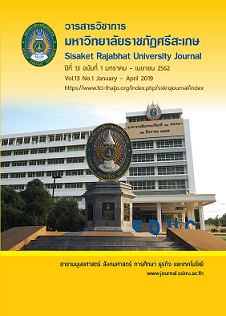Tourism Identity and Marketing in the Special Economic Zone (SEZ): Case Study of Northeast Thailand and Central Laos
Main Article Content
บทคัดย่อ
Northeast Thailand is considered to be in a great position to provide investors with new opportunities for increasing border trade and the region's rapid economic growth (Mekong Tourism Coordinating Office, 2017). With its strategic location in The Greater Mekong Subregion (GMS), the Northeast Thailand is an emerging-market zone of the country where connects other GMS countries: Cambodia, Laos, and Southern China (ASEAN, 2016). The Special Economic Zone (SEZ) was established in Mukdahan and Nakhon Phanom, the SEZ policy was first launched in Mukdahan in 2015 and 2016 in Nakhon Phanom (Thomson Reuters, 2016). It is based on the government's belief that the areas have strong potential to link with The SEZ in Laos in terms of trade, economy, investment, as well as tourism (Board of Investment, 2015).
The objectives of this study were (1) to survey identities of tourism attraction in the SEZ and set up the tourism routes, (2) to analyze tourists’ demand and expectation, and (3) to be guidance for tourism development and marketing. The data was obtained from related documents, participatory and non-participatory observations, questionnaire, and in-depth interviews of the key informants including government officials, entrepreneurs, tourists, and local people.
The findings showed that each of the SEZs has clear infrastructure development plans, public utilities (water and electricity), and customs services. In addition, there is infrastructure construction projects, R2 route (East-West Economic Corridor: EWEC), which connect Mukdahan (Thailand), Savannakhet (Laos), and Danang (Vietnam). According to the objectives, tourism identities can be categorized into four clusters: (1) Karst mountain loop, (2) Buddhist and Hindu temples route, (3) Old quarter with historic buildings, and (4) The Mekong River promenade. Most of the tourists come from ASEAN countries (Thailand, Laos, and Vietnam) and some tourists are from the Western (France, Germany, Italy, United Kingdom, Sweden, Norway, and the Netherlands). Regarding the tourist’s demand, they want activities such as experiencing river excursions, visiting war memorials sites, trekking in tropical rainforest, visiting remote community, and supporting for locally produced handicrafts, respectively.
Recommendations for tourism marketing in the SEZ are as follows: (1) create a remarkable product of the trans-boundary routes, particularly the Route no.8 tour from Nakhon Phanom to Laos (The Loop), and East–West Corridor tour (old quarter route, and pilgrimage route) from Mukdahan to Laos (Phin and Savannakhet); (2) improve accessibility to tourist attractions during monsoon season; (3) regularly inform tour operators about new events and activities in the area; (4) request for cooperation from local tour operators in each province of both Thailand and Laos to share experiences on tourism product, such as price and promotion, and find solutions to the identified problems; (5) persuade the international tour operators to the SEZ and introduce the tourism products; (6) promote cooperation with local authorities in terms of financial participation; (7) promote local events or festivals - inform tour operators via email, newsletters, especially when events or festivals are organized; (8) upgrade the tourist service standards (e.g. cooking, hygiene, management, front desk, housekeeping, etc.); (9) create a traditional gastronomic tourism, music festival, and international film festival; and (10) develop a quadrangle tourism model in the SEZ website or other social networks which is regularly updated.
Article Details
1. เนื้อหาและข้อมูลในบทความที่ลงตีพิมพ์ในวารสารวิชาการมหาวิทยาลัยราชภัฏศรีสะเกษ ถือเป็นข้อคิดเห็นและความรับผิดชอบของผู้เขียนบทความโดยตรง ซึ่งกองบรรณาธิการวารสาร ไม่จำเป็นต้องเห็นด้วย หรือร่วมรับผิดชอบใด ๆ
2. บทความ ข้อมูล เนื้อหา รูปภาพ ฯลฯ ที่ได้รับการตีพิมพ์ในวารสารวิชาการมหาวิทยาลัยราชภัฏศรีสะเกษ กองบรรณาธิการไม่สงวนสิทธิ์ในการคัดลอกบทความเพื่อการศึกษา แต่ให้อ้างอิงแหล่งที่มาให้ครบถ้วนสมบูรณ์
References
Preservation and Management Plan Khammouane Province 2016-2025. Vientiane:
ADB.
. (2016). The Role of Special Economic Zones in Improving Effectiveness of
GMS Economic Corridors. Manila: ADB.
ASEAN. (2016). ASEAN Tourism Strategic Plan 2016-2025. Jakarta: ASEAN Secretariat.
Board of Investment. (2015). Guide to Investment in the Special Economic
Development Zones (SEZs). Bangkok: BOI.
Concessionaire Laos People’s Democratic Republic. (2017). Phoukhyo Specific Economic
Zone. Vientaine: Concessionaire Laos People’s Democratic Republic.
Foreign Investment Advisory Service. (2011). Special Economic Zones: Performance,
Lessons Learned, and Implications for Zone Development. Washington, DC:
World Bank.
Kotler, Philip. (2012). Marketing Management.. London: Pearson Education Limited.
Lao National Tourism Administration. (2016). Savannakhet Province of Paradise. Vientiane:
LNTA.
. (2016). Tourism Market Study Savannakhet Province-Lao PDR. Vientiane: LNTA.
Ministry of Information, Culture and Tourism. (2016). Khammouane Province Tourism
Destination Management Plan 2016-2018. Vientiane: MICT.
Swisscontact. (2016). Khammouane Province Destination Management Plan: 2016 – 2018.
Vientiane: Swisscontact.
Mekong Tourism Coordinating Office. (2017). Greater Mekong Subregion Tourism Sector
Strategy 2016–2025. Bangkok: MTCO.
. (2018). Mekong Tourism Forum 2018. Bangkok: MTCO.
Thomson Reuters. (2016). Thailand Introduces Special Economic Zones. Toronto:
Thomson Reuters.

